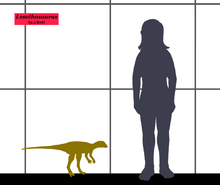Lesothosaurus
| Lesothosaurus Temporal range: Early Jurassic, 199–189 Ma | |
|---|---|
 | |
| Lesothosaurus diagnosticus skull | |
| Scientific classification | |
| Kingdom: | Animalia |
| Phylum: | Chordata |
| Class: | Reptilia |
| Clade: | Dinosauria |
| Order: | †Ornithischia |
| Clade: | †Genasauria |
| Clade: | †Neornithischia Halstead & Halstead, 1981 |
| Genus: | †Lesothosaurus Galton, 1978 |
| Species: | †L. diagnosticus |
| Binomial name | |
| Lesothosaurus diagnosticus Galton, 1978 | |
Lesothosaurus is an herbivorous ornithischian dinosaur. It was named by paleontologist Peter Galton in 1978, the name meaning "lizard from Lesotho". The genus is monotypic, having only one valid species, Lesothosaurus diagnosticus, within the genus.
Classification


Lesothosaurus was originally considered an ornithopod. However, more recent work by Paul Sereno has suggested that it may actually represent one of the most primitive of all known ornithischian dinosaurs. The taxonomic history of Lesothosaurus is complex and it has long been confused with Fabrosaurus, another small ornithischian from the same locality. In 2005, Richard J. Butler published a new phylogenetic study of ornithischians, in which he proposed that Lesothosaurus was a basal member of the clade Neornithischia, which includes pachycephalosaurs, ceratopsians and ornithopods. Alternatively, this dinosaur may be a very early thyreophoran, a member of the group including the armored stegosaurians and ankylosaurians.[1] The contemporaneous genus Stormbergia almost certainly represents the adult form of Lesothosaurus.[2] [3]
Description
Lesothosaurus was a 2 metres (6.6 ft) long, bipedal plant-eater. It was one of the earliest ornithischians. Its long slender legs, small arms with hands that would not have been able to grasp properly, and slender tail all suggest that it was a fast runner.[4][5] Like all ornithischians, the tips of Lesothosaurus upper and lower jaws were horny, forming a beaklike structure. Behind the beak were leaf-shaped teeth that lined the jaws, and near the front of the upper jaws were 12 fanglike teeth. Analysis of its teeth has shown that Lesothosaurus sliced up plant material with its beak and was not able to chew its food.[6]
The small skull of Lesothosaurus was short and flat, with large eye sockets. It had large cavities for the eye and jaw muscles. It had a short, pointed snout, and the lower jaw may have ended in a beak. Its teeth were pointed with grooved edges, and would have been ideal for chewing tough plant matter. The skull was mounted on a short but flexible neck.[4]
The hind limbs of Lesothosaurus were much longer than the forelimbs, which were quite short with small 'hands'. The hand had four well-developed fingers and a smaller fifth finger. The length of the rear legs indicates Lesothosaurus was a fast, agile runner. The distinctive femur has a unique femoral head not seen in other dinosaurs.
Lesothosaurus lived in the hot, arid conditions of Lesotho and South Africa, during the Early Jurassic. Remains of Lesothosaurus have been collected from the Upper Elliot Formation, dating it to the Hettangian to Sinemurian portions of the Early Jurassic.
More recent discoveries of Lesothosaurus in the upper Elliot formation suggest that this early ornithischian dinosaur may have lived in groups.[7]
References
- ↑ Butler, Richard J.; Upchurch, Paul; Norman, David B. (2008). "The phylogeny of the ornithischian dinosaurs". Journal of Systematic Palaeontology. 6 (1): 1–40. doi:10.1017/S1477201907002271.
- ↑ Knoll, F.; Padian, K.; de Ricqles, A. (2009). "Ontogenetic change and adult body size of the early ornithischian dinosaur Lesothosaurus diagnosticus: implications for basal ornithischian taxonomy". Gondwana Research. online. 17 (1): 171. doi:10.1016/j.gr.2009.03.010.
- ↑ Matthew G. Baron; David B. Norman; Paul M. Barrett (2016). "Postcranial anatomy of Lesothosaurus diagnosticus (Dinosauria: Ornithischia) from the Lower Jurassic of southern Africa: implications for basal ornithischian taxonomy and systematics". Zoological Journal of the Linnean Society. in press. doi:10.1111/zoj.12434
- 1 2 Palmer, D., ed. (1999). The Marshall Illustrated Encyclopedia of Dinosaurs and Prehistoric Animals. London: Marshall Editions. p. 134. ISBN 1-84028-152-9.
- ↑ Matthew G. Baron; David B. Norman; Paul M. Barrett (2016). "Postcranial anatomy of Lesothosaurus diagnosticus (Dinosauria: Ornithischia) from the Lower Jurassic of southern Africa: implications for basal ornithischian taxonomy and systematics". Zoological Journal of the Linnean Society. in press. doi:10.1111/zoj.12434
- ↑ Benton, Michael J. (2012). Prehistoric Life. Edinburgh, Scotland: Dorling Kindersley. p. 271. ISBN 978-0-7566-9910-9.
- ↑ Barrett, P. M., Butler, R. J., Yates, A. M., Baron, M. G., & Choiniere, J. N. (2016). New specimens of the basal ornithischian dinosaur Lesothosaurus diagnosticus Galton, 1978 from the Early Jurassic of South Africa.
Sources
- P. M. Galton. 1978. Fabrosauridae, the basal family of ornithischian dinosaurs (Reptilia: Ornithischia). Paläontologische Zeitschrift 52(1/2):138-159
- Butler, R.J., 2005. "The 'fabrosaurid' ornithischian dinosaurs of the Upper Elliot Formation (Lower Jurassic) of South Africa and Lesotho." Zoological Journal of the Linnean Society 145: 175-218.